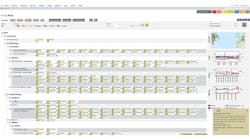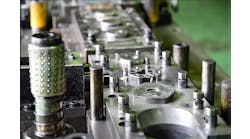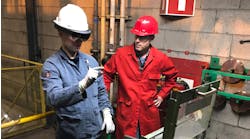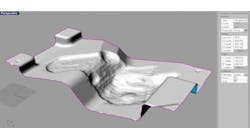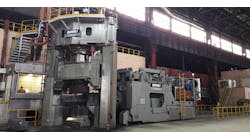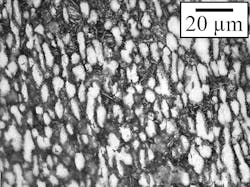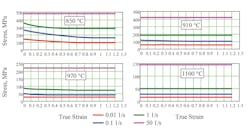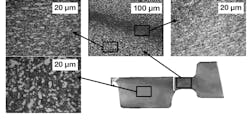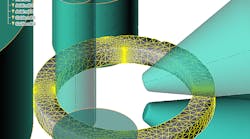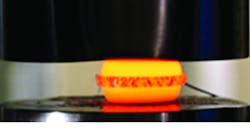Simulation of Microstructure Evolution of Ti Alloy During Hot Forging
The finite element method (FEM) is the most powerful tool for development and optimization of metal forming processes. Analysis of titanium-alloy critical parts should include the prediction of microstructure, since their mechanical and technological properties essentially depend on the type and parameters of the microstructure. The technological process of parts production for aerospace applications is multi-operational and consists of deformation, heating, and cooling stages.
Therefore, it is necessary to simulate the microstructure evolution to obtain high-quality parts. Here, FE simulation coupled with microstructure evolution during hot forging of TC11 titanium alloy has been performed by QForm FEM code.
Titanium alloys, particularly dual-phase titanium alloys, are in wide use as advanced structural materials in aeronautic applications[1][2]. TC11 is an α+β heat-resistant titanium alloy that is applicable for critical aerospace applications owing to its high strength-to-weight ratio, good corrosion resistance, and a high service temperature up to 500°C[3]. The alloy is widely used in aircraft engine compressor disks and blades and some airplane components. An understanding of the mechanisms of thermo-mechanical processing of this alloy will be highly beneficial to control its microstructure during manufacturing[4]. The objective of this study is to identify the flow behavior and friction conditions for a wide range of temperature and strain rate and to characterize the microstructural evolution of TC11 having initially α+β equiaxed microstructure during hot forging of a part, a lever.
Materials and procedures
Materials — The billet used in the present work was a 55-mm diameter, hot-rolled bar stock of TC11 titanium alloy (according to GB/T 2965-2007.) Its measured composition (in wt%) was 5.9% aluminum, 3.27% molybdenum, 1.40% zirconium, 0.2% silicon, and the balance of titanium.
The β transus for this material is about 1008°C. The study of TC11 alloy deformation behavior and microstructure evolution were performed in as-supplied state. The initial microstructure of TC11 is shown in Figure 1. Microstructure is bimodal with globular volume fraction of 0.4 and primary α-phase average grain size of 7.4 μm.
Figure 1.
Uniaxial Hot Compression Tests — Tests were performed with at low strain rate (≤ 1 s-1) by universal testing machine Zwick Z050 and at high strain rate (50 s-1) by Gleeble 3800 simulator. Tests were carried out in the isothermal state in the air in accordance with ASTM E0209-00[5]. An aqueous solution of hexagonal boron nitride was used as a lubricant.
Hot Ring Compression Tests — The ring compression test is a proven test[6][7] to determine friction factor m in Levanov friction law:
where τ – friction shear stress, MPa;
m – friction factor;
k – plasticity constant, MPa;
β – Levanov coefficient;
σn – normal pressure, MPa;
σs – flow stress, MPa.
In order to obtain the magnitude of friction factor the change in inner diameter of the compressed ring must be compared with this obtained from finite element analysis, for example by FEM commercial code QForm.
Microstructure characterization — Microstructure was characterized using optical microscopy images. The average grain size was evaluated by the random secant method according to GOST (Russian State Standard) 21073.3-75. The globular grains were identified by a ratio between the longitudinal and transversal sizes of no larger than 3:1. The volume fraction of globular α-phase in the bimodal structure was determined by computing the area occupied by globular grains using an overlaid mesh with a cell size of 5 μm.
Microstructure evolution model — The kinetics of recrystallization can be approximated fairly well by the Johnson-Mehl-Avrami-Kolmogorov equation (JMAK.) In our model the fraction of the volume that passed through dynamic recrystallization is calculated as follows:
where Ad, Md, Ld, Qd, Cd, bd, kd are constants.
Finite element method (FEM) analysis. Simulations were done using the QForm FEM commercial code. FEM analysis was used to obtain true strain-stress curves by temperature correction for compensation of deformation heating by iterative procedure.
Also, the friction factor was determined by means of inverse analysis. Input data included the specific sample and dies geometry, kinematics of forming equipment, heating history used in the experiments, TC11 flow-stress data corrected to exclude influence of deformation heating, thermophysical properties of TC11 alloy, the die material, and the value of the friction factor. All data except flow curves and friction conditions was taken from QForm deformed materials database.
Results and discussion
Flow Curves — To determine flow curves at elevated temperatures it is necessary to consider the non-homogeneity of deformation, the thermal deformation effect, and friction. The most effective method is an inverse analysis.
The inverse analysis technique for determining the flow stress curve was developed by Cho and Altan[8] and in presented work we have used this technique for different temperature and strain rate conditions. The set of flow curves is given in tabular form. The objective function is the following expression:
where is the number of flow curves;
N is the number of points approximating the flow stress curve;
Fij is the an experimentally determined force at a point, N; and
Fij(ρ) is the calculated force at point, N.
Figure 2.
To minimize the objective function an iterative algorithm and an optimizer were used. Specimens after deformation are shown in Figure 2.
Figure 3.
The flow stress curves for the temperatures from 850°C to 1100°C are presented in Figure 3. As we see, only within the narrow range of temperature and strain rate the material softening can be observed. For the rest range of the temperature and strain rate TC11 alloy behaves as an ideal viscous-plastic material having constant flow stress.
Figure 4.
Friction Conditions — The friction factor was studied in the temperature range from 850°C to 970°C. The samples after deformation are shown in Figure 4.
A plot of the friction factor versus temperature is shown in Figure 5. As we can see the friction factor of TC11 alloy is highly dependent on the temperature of deformation.
Figure 5.
Process characterization – Deformation behavior and microstructure evolution of TC11 Titanium alloy have been investigated during hot forging of the “lever” (see Figure 6.)
Figure 6.
The technological process includes the following stages: heating to forging temperature 970°C, upsetting, preforming, flash trimming, reheating, final forging and second flash trimming (see Figure 7.)
Figure 7.
Microstructure characterization and further FEM analysis were carried out in certain crosscut sections that are shown in Figure 8.
Figure 8.
Typical microstructure after upsetting can be characterized as bimodal with volume fraction of recrystallized α-phase of 0.16 (see Figure 9a.)
Macrograph and typical microstructure after preforming are shown in Figures 9b and 9c. Microstructure is almost homogeneous with volume fraction of recrystallized α-phase of 0.26.
Figure 9.
Macrograph and typical microstructures after final forming in Sections 3 and 4 are shown in Figure 10 and Figure 11, respectively. As we can see there is almost homogeneous microstructure in bosses with volume fraction of the recrystallized α-phase of 0.40 and localized flow bands in adapters with volume fraction of recrystallized α-phase of 0.68.
Figure 10.
Figure 11.
FEM Simulation — Strain distributions obtained by means of simulation of the technological process in FEM commercial code QForm are shown in Figure 12.
Figure 12.
Predicted distributions of the recrystallized volume fraction of α-phase are shown in Figure 13.
Figure 13.
As we can see the simulation predicts deformation localization in adapters. Predicted recrystallized α-phase volume fraction also corresponds well to experimental data.
Summary and conclusions
1. The model of microstructural evolution based on JMAK approach was implemented in QForm FEM code.
2. Hot deformation behavior of TC11 alloy with an equiaxed α+β starting microstructure was investigated by means of isothermal compression tests in the temperature range 850–1100°C and strain rate range 0.01–50 s-1.
3. Friction conditions in the temperature range 850–970°C were investigated by ring compression tests in the temperature range 850–970°C.
4. Deformation behavior and microstructure evolution of TC11 titanium alloy during hot forging of a lever were analyzed.
5. Predicted distributions of recrystallized volume fraction of α-phase are in good agreement with the experimental data.
Artem Alimov heads the Metalforming Technology Laboratory faculty at Russia’s Bauman Moscow State Technical University. Contact him at [email protected]
Dmitry Zabelyan and Igor Burlakov are affiliated with JSC Gas-Turbine Engineering Research and Production Center, Salut, a designer/manufacturer of aerospace engines.
Yuri Gladkov is the managing director of business development for QuantorForm Ltd. Contact him at [email protected]
References
[1] H.W. Song, S.H. Zhang, M. Cheng. Dynamic globularization prediction during cogging process of large size TC11 titanium alloy billet with lamellar structure. Defence Technology 10.1 (2014), 40-46.
[2] Y.Y. Zong, D.B. Shan, M. Xu, Y. Lv Flow softening and microstructural evolution of TC11 titanium alloy during hot deformation. Journal of materials processing technology 209.4 (2009), 1988-1994.
[3] L.X. Li, Y. Lou, L. B. Yang, D. S. Peng, K. P. Rao Flow stress behavior and deformation characteristics of Ti-3Al-5V-5Mo compressed at elevated temperatures. Materials & Design 23.5 (2002), 451-457.
[4] R.Y. Sukhorukov, A. A. Sidorov, A. I. Alimov, M. I. Nagimov & F. Z. Utyashev Physical and numerical modeling of the process of rolling off of a tapered shaft of aviation purpose. Journal of Machinery Manufacture and Reliability 45.6 (2016), 538-545.
[5] ASTM E0209-00 Practice for Compression Tests of Metallic Materials at Elevated Temperatures with Conventional or Rapid Heating Rates and Strain Rates.
[6] T. Altan, S.I. Oh, H.L. Gegel Metal forming: fundamentals and application. American Society for Metals, Metal Park, 1983.
[7] E.M. Mielnik Metalworking science and engineering. McGraw-Hill, New York, 1991.
[8] H. Cho, T. Altan Determination of flow stress and interface friction at elevated temperatures by inverse analysis technique. Journal of materials processing technology, 170(1-2) (2005), 64-70.

